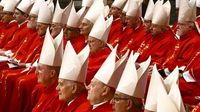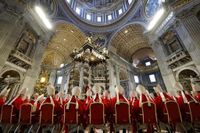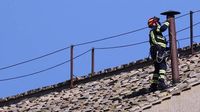As the Catholic Church prepares for a pivotal moment in its history, 133 cardinals are set to gather at the Vatican on May 7, 2025, to elect a new pope following the death of Pope Francis. The conclave, which will take place in the Sistine Chapel, aims to reach a consensus in less than three days, a timeline emphasized by Cardinal Gregorio Rosa Chavez, who expressed confidence that the process would be efficient. Observers note that a prolonged conclave could signal divisions within the Church, which has faced significant challenges in recent years.
The average duration of conclaves has been approximately 3.2 days, with the last two elections—those of Pope Benedict XVI in 2005 and Pope Francis in 2013—lasting only two days. The cardinals will require a two-thirds majority, or 89 votes, to elect the next leader of the Catholic Church. Once a pope is chosen, white smoke will billow from a chimney above the chapel, marking the announcement of the election.
In the lead-up to the conclave, online betting platforms have seen a surge in activity, with over 5.7 million dollars (5 million euros) wagered on potential candidates. Pietro Parolin, the Italian Secretary of State, is currently favored to succeed Pope Francis, followed closely by Filipino Cardinal Luis Antonio Tagle. The betting frenzy reflects a cultural fascination with the papacy, reminiscent of the public's interest in royal births.
As the cardinals prepare for their discussions, the stakes are high. The expected pope must navigate a diverse Church and address the growing secularization affecting the global Catholic community. The goal is to revitalize evangelization efforts and bring unity among the faithful. Many cardinals are hopeful that the new leader will continue the progressive reforms initiated by Pope Francis, which emphasized inclusivity and transparency within the Church.
The conclave will commence with an initial vote serving as an informal gauge of support for various candidates. Starting on the second day, two rounds of voting will occur in the morning and two in the afternoon. If no candidate achieves the required majority after three days, a day of prayer will be observed before voting resumes.
Cardinal Pietro Parolin, once seen as the frontrunner, faces challenges that have cast doubt on his candidacy. His controversial agreement with China, which has raised concerns among some high-ranking clerics, is viewed as a potential liability. Critics argue that the deal compromises the Church's position in favor of political expediency, leading to calls for a leader who can better represent the Church's interests.
Meanwhile, other candidates are also in the mix. Cardinal Luis Antonio Tagle, who has garnered significant support, is seen as a potential unifying figure capable of bridging various factions within the Church. Additionally, the Ghanaian Cardinal Peter Turkson, who could become the first Black pope, is also among the favorites, demonstrating the global and diverse nature of the current College of Cardinals.
As the cardinals convene, they will engage in private discussions to build consensus around their preferred candidates. While formal campaigning is prohibited, informal conversations during meals at the Vatican will likely play a crucial role in shaping the outcome. The dynamics of these interactions will be critical as the cardinals strive to elect a pope who can lead the Church through a period of uncertainty and change.
In the past, the conclave process has been marked by unexpected turns. For instance, during the 2013 election, Jorge Mario Bergoglio, who would become Pope Francis, was not initially considered a leading candidate but gained momentum through powerful speeches and support from unexpected quarters. Such surprises are part of the intrigue surrounding papal elections, and this conclave is no exception.
The anticipation surrounding the upcoming conclave is palpable, with many hoping for a swift resolution to the election. The cardinals are aware that the world is watching, and the implications of their choice will resonate far beyond the walls of the Vatican. As they prepare to cast their votes, they carry the weight of history on their shoulders, tasked with selecting a leader who will guide the Catholic Church into a new era.
With the chimney atop the Sistine Chapel now in place, the signal of smoke will soon become a focal point for millions around the world. Black smoke will indicate that no pope has been elected, while white smoke will announce the successful election of a new pontiff. The ritual of the conclave, steeped in tradition and history, continues to capture the imagination of the faithful and observers alike.
In conclusion, the upcoming conclave represents not just a transition of leadership but a pivotal moment for the Catholic Church as it seeks to address contemporary challenges while remaining rooted in its rich heritage. The cardinals' deliberations will undoubtedly shape the future of the Church, and their choice will echo through generations.



